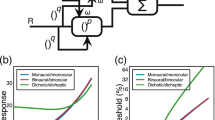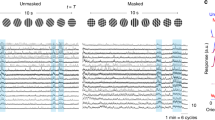Abstract
Some aspects of masking phenomena are considered in terms of the simplest possible model of two-factor neural elements. The effect of a number of variables can be accounted for, but the introduction of an internuncial element results in a masking function which need not be symmetric about zero delay interval. As an illustration, the results for a special case are compared with available data. In general, such a model results in a masking function which depends on the intensity, area, and duration of the stimuli, as well as on the temporal and spatial separation between them.
Similar content being viewed by others
Literature
Alpern, M. 1953. “Metacontrast.”J. Opt. Soc. Amer.,43, 648–657.
Kolers, P. and B. Rosner. 1960. “On Visual Masking (metacontrast): Dichoptic Observation.”Amer. J. Psychol.,73, 2–21.
Landahl, H. D. 1962. “Mathematical Models for the Representation of Neural Interaction.” InPhysico-Mathematical Aspects of Biology, N. Rashevsky, Ed. New York: Academic Press, 287–294.
— 1957. “On the Interpretation of the Effect of Area on the Critical Flicker Frequency.”Bull. Math. Biophysics,19, 157–162.
Raab, D. H. 1963. “Backward Masking.”Psychol. Bull.,60, 118–129.
Rashevsky, N. 1960.Mathematical Biophysics, Rev. Ed. Vol. 1. New York: Dover Publications, Inc.
Weisstein, N. and R. N. Haber. 1965. “A U-shaped Backward Masking Function in Vision.”Psychonomic Sci.,2, 75–76.
— 1966. “Backwards Masking and Models of Perceptual Processing.”J. Exp. Psychol. 72, 232–240.
Author information
Authors and Affiliations
Rights and permissions
About this article
Cite this article
Landahl, H.D. A neural net model for masking phenomena. Bulletin of Mathematical Biophysics 29, 227–232 (1967). https://doi.org/10.1007/BF02476896
Received:
Issue Date:
DOI: https://doi.org/10.1007/BF02476896




